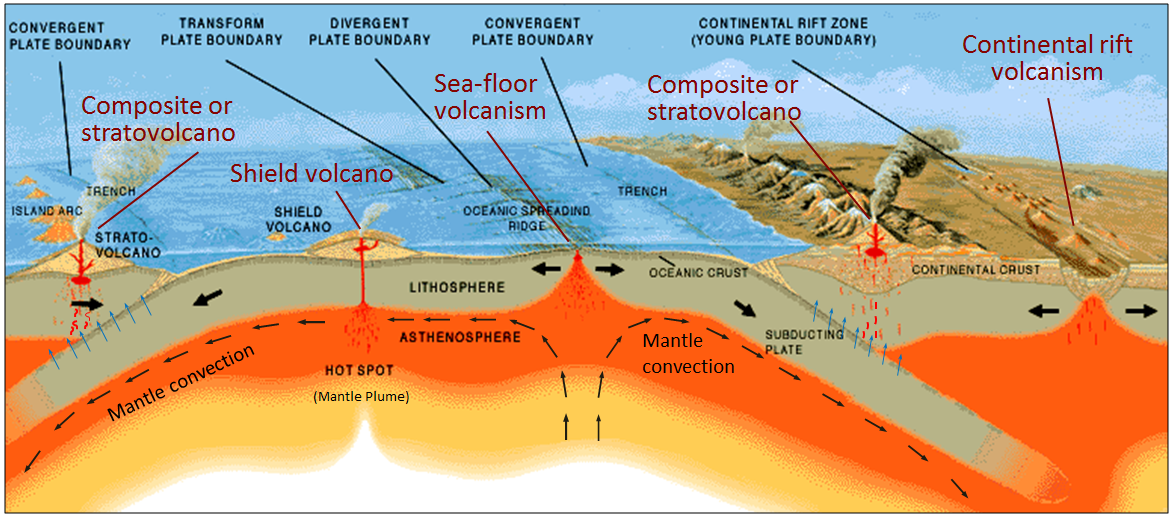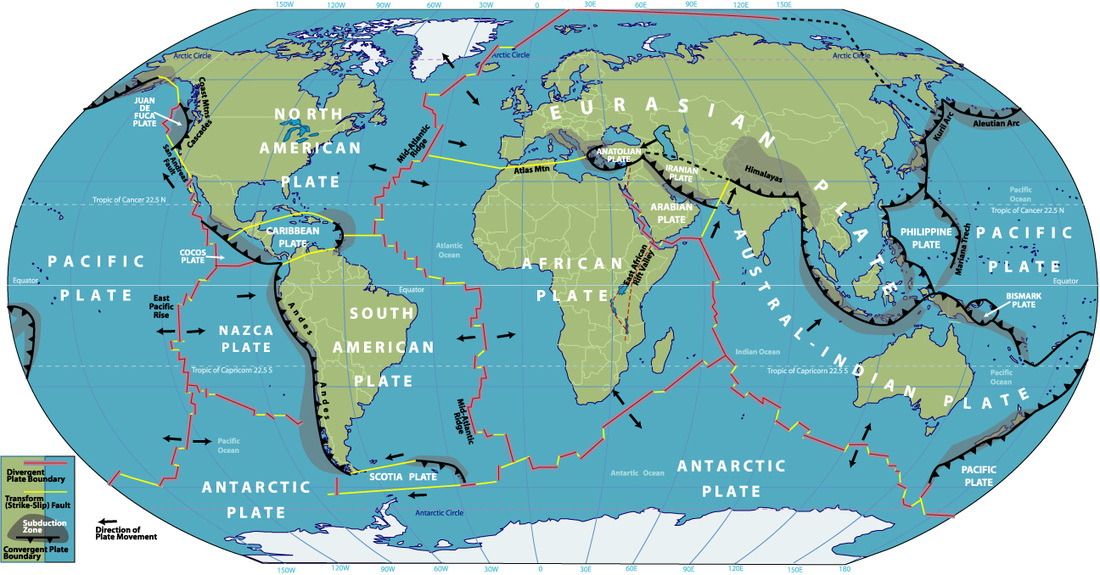
Lateral density variations in the mantle result in convection that is, the slow creeping motion of Earth's solid mantle. Tectonic plates are able to move because Earth's lithosphere has greater mechanical strength than the underlying asthenosphere. Earlier theories, since disproven, proposed gradual shrinking (contraction) or gradual expansion of the globe. This prediction of plate tectonics is also referred to as the conveyor belt principle. In this way, the total geoid surface area of the lithosphere remains constant. Along convergent boundaries, the process of subduction, or one plate moving under another, carries the edge of the lower one down into the mantle the area of material lost is balanced by the formation of new (oceanic) crust along divergent margins by seafloor spreading. Tectonic plates are composed of the oceanic lithosphere and the thicker continental lithosphere, each topped by its own kind of crust. The relative movement of the plates typically ranges from zero to 10 cm annually.

Earthquakes, volcanic activity, mountain-building, and oceanic trench formation occur along these plate boundaries (or faults). Where the plates meet, their relative motion determines the type of plate boundary: convergent, divergent, or transform. Plate tectonics came to be generally accepted by geoscientists after seafloor spreading was validated in the mid to late 1960s.Įarth's lithosphere, which is the rigid outermost shell of the planet (the crust and upper mantle), is broken into seven or eight major plates (depending on how they are defined) and many minor plates or "platelets". The model builds on the concept of continental drift, an idea developed during the first decades of the 20th century. A mid-ocean ridge would then mark the boundary between the plates.Plate tectonics (from the Late Latin: tectonicus, from the Ancient Greek: τεκτονικός, lit.'pertaining to building') is the generally accepted scientific theory that considers the Earth's lithosphere to comprise a number of large tectonic plates which have been slowly moving since about 3.4 billion years ago. If the plates there continue to diverge, millions of years from now eastern Africa will split from the continent to form a new landmass. On land, giant troughs such as the Great Rift Valley in Africa form where plates are tugged apart. A single mid-ocean ridge system connects the world's oceans, making the ridge the longest mountain range in the world. The process renews the ocean floor and widens the giant basins. Mountains and volcanoes rise along the seam. Divergent BoundariesĪt divergent boundaries in the oceans, magma from deep in the Earth's mantle rises toward the surface and pushes apart two or more plates. These types of collisions can also lead to underwater volcanoes that eventually build up into island arcs like Japan. In addition, the diving plate melts and is often spewed out in volcanic eruptions such as those that formed some of the mountains in the Andes of South America.Īt ocean-ocean convergences, one plate usually dives beneath the other, forming deep trenches like the Mariana Trench in the North Pacific Ocean, the deepest point on Earth. As the overlying plate lifts up, it also forms mountain ranges. These convergent boundaries also occur where a plate of ocean dives, in a process called subduction, under a landmass. Mount Everest, the highest point on Earth, may be a tiny bit taller tomorrow than it is today. As the mash-up continues, the mountains get higher. India and Asia crashed about 55 million years ago, slowly giving rise to the Himalaya, the highest mountain system on Earth. Where plates serving landmasses collide, the crust crumples and buckles into mountain ranges. They move at a rate of one to two inches (three to five centimeters) per year. The movement of the plates creates three types of tectonic boundaries: convergent, where plates move into one another divergent, where plates move apart and transform, where plates move sideways in relation to each other. Most geologic activity stems from the interplay where the plates meet or divide.

(This includes the crust and uppermost part of the mantle.) Churning currents in the molten rocks below propel them along like a jumble of conveyor belts in disrepair. The plates make up Earth's outer shell, called the lithosphere. The tiny Juan de Fuca plate is largely responsible for the volcanoes that dot the Pacific Northwest of the United States. Though smaller in size, the minors are no less important when it comes to shaping the Earth. Six of the majors are named for the continents embedded within them, such as the North American, African, and Antarctic plates. There are a few handfuls of major plates and dozens of smaller, or minor, plates.


 0 kommentar(er)
0 kommentar(er)
